Weekend Of A Thousand Artisanal Stevies
What’s not to do this weekend? In particularl may we point you to the Brooklyn Flea Record Fair and the Bust Magazine Spring Craftacular?
I'm Nobody: Eve Sedgwick After Death
by Jane Hu

Eve Kosofsky Sedgwick would have been 63 today. Four years have passed since her death, but her absence is felt more, not less, with each. More than ever Sedgwick’s writing generates further writing and thinking from those who engage with it.
Sedgwick once said about reading affect theorist Silvan Tomkins: “I often get tired when I’m learning a lot.” Her writing has the same effect — calming and invigorating — generative and tireless even if also sometimes tiring. In her posthumous collection, The Weather In Proust (2011), Sedgwick remarks that one form of antinormative reading can lead to many other types of theorizing — this is exactly how I feel about Sedgwick’s work. Forever against foreclosure, Sedgwick and the fact of her death is still something we’re coming to terms with. It’s difficult to think that she’s not alive.
Some know her as the academic who titled an MLA essay “Jane Austen and the Masturbating Girl,” which has become something of a shorthand for “LOL academics” in the Times. (Roger Rosenblatt, without naming the author, listed it as an example of “academic idiocy” that was “hair-raising”; Christopher Hitchens paraphrased the title “only slightly,” by which I mean not at all slightly.) To those that throw the title around without reading the essay, though, lulz are on you. “Jane Austen and the Masturbating Girl” looks precisely at the act that journalism was accusing it of ignorantly enacting.
As Sedgwick later noted:
[T]he literal-minded and censorious metaphor that labels any criticism one doesn’t like, or doesn’t understand, with the would-be-damning epithet ‘mental masturbation,” actually refers to a much vaster, indeed foundational open secret about how hard it is to circumscribe the vibrations of the highly relational but, in practical terms, solitary pleasure and adventure of writing itself.
One’s first encounter with Sedgwick’s writing seems significant, for reading Sedgwick gives one the intense sensation of being known — she is the most generous, enabling thinker. While students of the 90s likely first came to Sedgwick by way of Between Men (1985) or Epistemology of the Closet (1990), these days, it’s just as likely that one will discover her through her later work on affect theory.
“Paranoid Reading and Reparative Reading, or, You’re So Paranoid, You Probably Think This Essay Is About You” — with its smashing Carly Simon reference — was my first Sedgwick essay. I remember beginning by reading it on my computer, until partway through when printing it became a necessity because there was too much to annotate and underline. By the end, I only had exclamation marks and hearts as marginalia. It’s an essay, like all Sedgwick essays, to be returned to, and this part continues to break my heart wide open each time:
Because there can be terrible surprises, however, there can also be good ones. Hope, often a fracturing, even a traumatic thing to experience, is among the energies by which the reparatively positioned reader tries to organize the fragments and part-objects she encounters or creates. Because the reader has room to realize that the future may be different from the present, it is also possible for her to entertain such profoundly painful, profoundly relieving, ethically crucial possibilities as that the past, in turn, could have happened differently from the way it actually did.
When Sedgwick wrote Epistemology of the Closet (the book from her earlier work that would most significantly go on to shape gay and lesbian studies), “queer” was hardly part of any conversation — mainstream, academic, or otherwise. At least, not in the way that we understand “queer” now in reference to Queer Theory. (The word appears only twice in the entirety of the book.) Instead, Sedgwick called hers an “antihomophobic theory” — phrasing that might strike us now as restrictive, though her theory was anything but. Throughout the remarkable document, she makes a point to repeat the ambition of her argument — Epistemology of the Closet will be overly inclusive in its thinking so as to open up the conversation to further inquiry:
I’ve wanted the book to be inviting (as well as imperative) but resolutely non-algorithmic. A point of the book is not to know how far its insights and projects are generalizable, not to be able to say in advance where the semantic specificity of these issues gives over to (or: itself structures?) the syntax of a “broader” or more abstractable critical project. In particular, the book aims to resist in every way it can the deadening pretended knowingness by which the chisel of modern homo/heterosexual definitional crisis tends, in public discourse, to be hammered most fatally home.
Sedgwick not only hoped but urged others to intervene in her thinking as a way of moving forward — either by expanding upon, departing from, or rejecting entirely. And they did! Queer and sexuality studies has radically flourished since the publication of Epistemology, though, as the book emphatically stated: “People are different from each other.” (Let’s just think about that for a moment.)
That the critics (and the Times!) kept returning to mock Sedgwick is a reminder of this. (Or perhaps, it’s that no one will ever be close to resembling Sedgwick.) Dinitia Smith’s 1998 piece leaves me freshly horrified each time:
Queer theory, which Ms. Sedgwick developed along with Judith Butler, a professor at the University of California, Berkeley, is a prism through which scholars examine literary texts.
It gets worse, and it continues after death. And though we have few words for “racism as criticism” Bruce Bawer, remember when he waxed ignorant about Sedgwick in his 2012 book? This is all obviously anti-intellectual bullshit of the highest order.
We need to keep making space for the different, and Sedgwick, especially, knew the virtue of returning and rereading — of changing one’s mind. In a 1999 interview, Sedgwick remarked on the difference between what she categorized as knowing and realizing:
It’s hard to recognize that your whole being, your soul doesn’t move at the speed of your cognition… That it could take you a year to really know something that you intellectually believe in a second… how not to feel ashamed of the amount of time things take, or the recalcitrance of emotional or personal change.
And if reading Between Men or Epistemology jars us somewhat back to the eighties, Sedgwick also proves the exception to the rule (perhaps being the least reactionary of all radical theorists from then, and certainly not rooted in sex positivism). She made a crucial intervention — in feminism, in antihomophobic studies, in scholarship — that was needed then, and remains relevant (and still needed!) today:
If it is still in important respects the master-canon it nevertheless cannot now escape naming itsef with every syllable also a particular canon, a canon of mastery, in this case of men’s mastery over, and over against, women. Perhaps never again need women — need, one hopes, anybody — feel greeted by the Norton Anthology of mostly white men’s Literature with the implied insolent salutation, “I’m nobody. Who are you?”
In 1998 — just over a decade before her death, and a few years after the recurrence of her breast cancer — Sedgwick published a lyrical essay in the prestigious academic journal Critical Inquiry about her searching therapy sessions. The piece is titled “A Dialogue on Love,” and is spaced almost poetically (Sedgwick started out as an aspiring poet), where she reiterates conversations with her therapist:
What I’m proudest of, I guess, is having a life where work and love are impossible to tell apart. Most of my academic work is about gay men, so it might seem strange to you that I would say that — not being a man, not even, I don’t think, being gay. But it’s still true. The work is about sex and love and desire, to begin with — like your work I suppose — so it’s almost bound to be involving at that intimate level. But beyond that, even — Oh, where to start!
Jane Hu has feels. You can follow her here. Photo by by David Shankbone.
New York City, May 1, 2013

★★★★ The green in the trees had gone from tentative to lush. Iridescent green badges flashed and vanished on a starling’s shoulders as it turned this way and that; a petal had fallen from a tree to rest on a petal of a tulip. The blooming trees on the Broadway median were one continuous mass. Prospects were spacious all around. Broadway was chilly in the breeze, but the Time Warner Center was a solar collector. Out over the office fire escape — between the frigid air conditioning and the rooftop closed for repainting — wine-crimson maple leaves crowned the dirty white side of the building. The foot of the brick wall on Prince Street was dusted with a luminous green line of tree sex organs. Somewhere overhead, a helicopter chattered, and a police car was sideways across Houston Street. At the far end of the block, red flags were rippling as a parade column turned left.
Could Your Handwriting Cost You That CEO Gig?
What does your handwriting say about you? SPOILER: Nothing. Which is probably good, because when is the last time you spent any time writing anything by hand? Didn’t you cramp up in like thirty seconds because your wrist was all, “What? I thought we GOT OUT OF THIS BUSINESS!” Anyway, if you’re in France you might not get a job because you have bad handwriting, but you probably have bigger problems, what with being French and all.
Larry Gatlin Is 65
Country musician Larry Wayne Gatlin turns 65 today, which is pretty much all the excuse I need to run this clip here. If you stick around long enough the Gatlin Brothers play “All The Gold In California,” but I am mainly putting it up to remind (or inform) you that this is what America was once like, and there weren’t a whole lot of other options if you weren’t into it. It’s a funny old world. (Younger readers who are completely baffled might find some clarity here, but it’s not going to explain everything.)
A Poem By Megan Amram
by Mark Bibbins, Editor
Ice Queen
5 a.m. (4 a.m. EST)
The island from above
Became a hook, gesturing.
Filled with sounds,
The shape of three fingers.
The family, bereft,
Witness to the 5 a.m.
The bruise-colored money left.
The motorcade on the left.
The slit, a haiku:
Focused, deep as a tap.
To stab a man,
To write a haiku.
Crimson almost-morning:
The abettor.
Bermuda has
One more flower.
I could feel the gushing of morning coming on.
The road acted its role admirably.
I was a visitor in an intimate land of hand-violence.
The sky was a place of water-stitched clouds.
The houses were each colored like a type of Bermuda wound.
You juggled the affliction of the parking lot passing,
The gift of being native to somewhere.
The cricket song stabbed the night, black as the soles of my feet.
I paid to touch down here, to view the throbbing iguana.
I enjoy my subtropical epiphany, that people die in Bermuda.
I bested the palm’s best frond.
I was an hour older than myself.
The flowers shattered the silence of the monochrome,
The unfinished cathedral of St. Catherine.
And I see the drink in the air, I see the breeze sagging with storm,
I note it all, I note the shadows of the palms, lazy, tanning;
I note the white bones of the gravestones and
the whiter bones below.
Megan Amram is a graduate of Harvard University and comedy writer living in Los Angeles.
Poems poems poems, we’re busting out all over with poems. You may contact the editor at poems@theawl.com.
Eight Great Things You Can Eat This Spring That Are Definitely Not Ramps
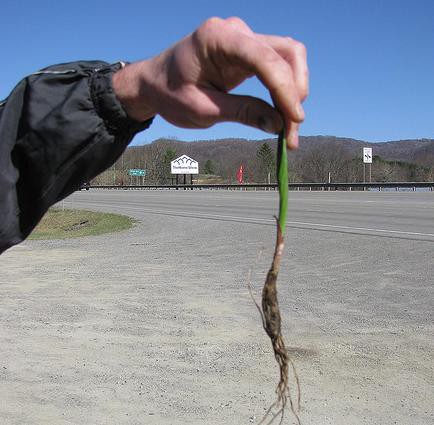
Ramps are fine. I will not bash any of the members of the House Of Allium, one of the most illustrious families of food. Tasty things can and have been done with them! But they are neither the only nor the best item that springtime has to offer. Eating seasonally does not necessarily require spending seven dollars on five tiny leafy scallions. This is not ramp season, my friends. This is a time of so much more. Here’s a list of timely delicacies you should be gorging on, sans ramps.
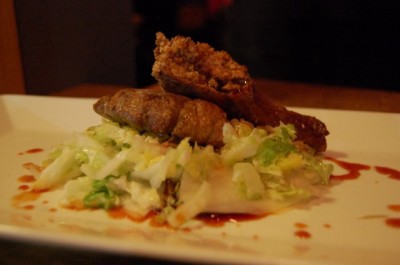
SHAD and SHAD ROE
Shad is a fish in the herring family, sometimes called a river herring. It migrates in the springtime along the rivers of the northeast and mid-Atlantic U.S. George Washington caught them in the Potomac. In 2010, shad fishing in the Hudson was outlawed, due to population crash — but the Delaware river is having a good run this year. It is also delicious, though like so many of the Atlantic’s great and humble fishes, it is oily and bony and kind of a pain in the ass to prepare. But do not let this deter you!
What to do with it: You can purchase it whole, and try to get females. The body can be roasted, grilled, smoked, or cedar-planked — like a lot of oily fish, it takes well to smoke — but the true prize is the roe. You can also get shad deboned almost anywhere you can get shad (try Citarella); that’s easier on the bone-averse. And you can also buy sets. Shad roe is one of the Atlantic’s great delicacies, tasting almost like sweetbreads. Sautee it in bacon fat and serve it with potatoes, herbs, and a squeeze of lemon, or roast it slowly.
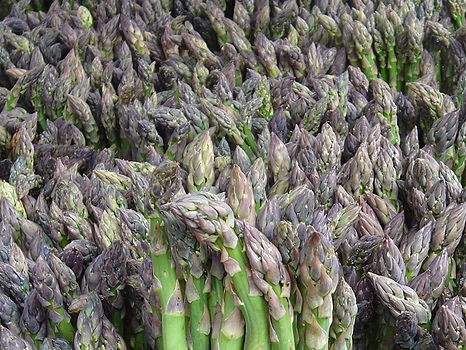
ASPARAGUS
Asparagus is the best. You should eat some!
What to do with it: Raw in salads, grilled, stir-fried, shaved and used as “pasta,” pulverized into pesto, roasted. My favorite is a pizza, with some kind of herb pesto, goat cheese, asparagus on top, and an egg. Pre-bake the pizza with everything but the egg, then crack the egg in the middle of the pie and continue baking until the white of the egg sets but the yolk is still runny.

NETTLES
Stinging nettles are a menacing, vindictive weed, covered with thousands of tiny poisonous spikes that hurt when you touch them. Punish this awful plant by eating it. Luckily, it’s also delicious, kind of like spinach, but with a stronger flavor, and remarkably good for you. It’s one of the few greens that has a lot of protein, so it’s great for vegetarians.
What to do with it: Use gloves when handling — they seriously do hurt — and remove the leaves from the stems. Wash ’em. Then sautee the same way you would spinach; heat (or even water) removes the stupid little spines. They are spectacular with pasta, like a lot of spring ingredients. Try mixing them with ricotta for a ravioli stuffing or lasagna layer.

RHUBARB
Rhubarb is a great, underrated vegetable. It’s kind of sour naturally, so it’s usually used to counterbalance sweet items in desserts, but you can use that sweet-sour thing for savory dishes, too.
What to do with it: Rhubarb is mostly water, so it’ll break down pretty much any way you cook it. Chop it up and stew it with a lot of sugar and a little salt (and any other fruit, if you want) for a compote. Rhubarb compote is awesome on crepes or pancakes but even better on vanilla ice cream. (Oh mannnnn rhubarb compote on vanilla ice cream so goooood.) Or you could roast with less sugar and a little orange juice, mash, and use as a thick sweet/sour sauce for roast pork.

PEAS
Peas and pea shoots are delicate and sweet, and are great in simple preparations:risotto, sauteed with prosciutto and served with pasta, that kind of thing.
What to do with it: My favorite thing to do with edible-pod peas, like sugar snap peas, is a sort of inauthentic Thai-style stir-fry. Sweat garlic, onion, and ginger in a wok on low heat, then turn it up to high and toss in the (trimmed) peas and a handful of peanuts. Cook briefly — they should be hot but still very crisp — and serve with a dressing of lime juice, fish sauce, brown sugar, and chili garlic paste (the kind that looks like chunky sriracha and comes in a little cylindrical plastic jar). Excellent with fish.

FAVAS
The fava bean, or broad bean, is sweeter and lighter than most legumes we get here in New York, but that just means that whatever you use it for will end up sweeter and lighter and more delicious.
What to do with it: They’re kind of a pain to shell; there’s actually two seed-coverings, so you have to shell them, boil them, shock them in ice water, and then pop them out of their second skin. But they keep at that stage for awhile, and they are very, very tasty. You can: Make a hummus-like dip with olive oil and basil; deep-fry them and season with salt and chili powder (this makes them into crunchy bar snacks); throw whole into vegetable soups; eat in salads with peas, mint, pine nuts, and feta cheese; or, for something heartier, boil and smash and use them as a healthier, richer version of mashed potatoes.
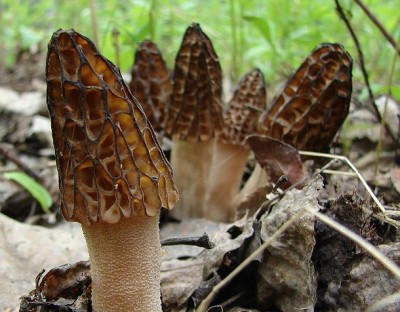
MORELS
Morels are the little, very expensive honeycomb-looking mushrooms you skip over at Whole Foods because they cost like one month’s rent/lb. They’re slightly cheaper when they’re in season around here, and you can also get a guide and go out mushrooming in the forest, which is, yes, the kind of thing you’ll be a LITTLE embarrassed to do, but also you’re basically just going for a nice walk in the woods and then you come away with like fifty bucks worth of delicious mushrooms, so.
What to do with it: Clean them with a brush; like other mushrooms, they’ll soak up water and lose their nice texture if you wash them in water. They’re slightly toxic when raw, but are very easy and forgiving to cook. They pair especially well with eggs. You can sautee in butter and drop a poached or sunny-side egg on top. You can sautee with peas, put them in a little ramekin, crack an egg on top, and grate some parmesan over that, then bake until the whites of the egg are set. You can do a simple pan-fry with an egg batter and breadcrumbs. They are also excellent with game, especially venison.
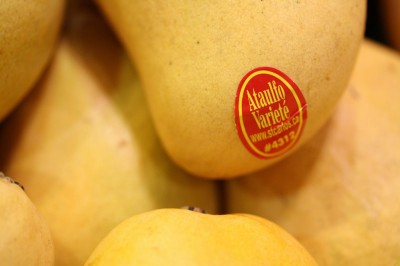
MANGOES
Ah ha, you thought this was all going to be tender shoots and legumes and colonial-sounding stuff from the northeast, didn’t you? I have been told on good authority that New York is not the only place with seasons, and that in other parts of the world, fruits and vegetables have ebbs and flows in much the same way they do here! Mangoes begin coming into season in Florida in May, continuing into October, but they are in season in springtime from Mexico on down through Central America. Since we’ve gotten pretty good at moving stuff around with planes and boats and things, you can enjoy them in the borough or northern state of your choosing!
There are hundreds of varieties of mango beyond the Tommy Atkins mango, the jumbo red and green variety we mostly see in this part of the world. Slightly less common, but much more delicious, is the Ataulfo or champagne mango, a smaller, golden, kidney-shaped fruit that’s more intense in flavor and more lenient in its ripening cycle. It’s hard to find the more exotic varieties here; you can try Indian markets in Jackson Heights or Mexican markets in Sunset Park, but I can’t promise you’ll find anything.
What to do with it: Both the Tommy Atkins and Ataulfo mango should be a bit soft to the touch, like a ripe avocado. Completely unripe, green mangoes can be used for salads and slaws, but just a hard, “unripe” mango is not usually “green” and will be too sweet for this. Ripe mangoes are just about perfect raw, but I also really like throwing them in a food processor with cayenne pepper, a little lime juice, and salt, blending them up, and pouring them into popsicle molds for chili-mango popsicles.
Dan Nosowitz writes words for money. He has serious opinions about fruit. Sad dangling ramp photo by Natalie Maynor. Shad roe photo by Stuart Spivack. Mango photo by Danielle Scott.
"Pirate" Means So Many Different Things These Days
“A branch of the Women’s Institute who dressed as pirates to welcome a guest speaker on piracy realised they had made an embarrassing mistake — because he was actually giving a talk on being held hostage by Somalians.”
Third "Sex and the City" Movie Threatened

In this one, the first 40 minutes are just the ladies on a rooftop in Williamsburg, throwing rotten vegetables at the 20-somethings below. Then Miranda does a $12-million Kickstarter to fund her new boutique law firm. Charlotte fires her household staff. Samantha has sex with some men. Carrie, now single, writes a column for XO Jane and, whilst picking up her $45 check in the office, meets Lena Dunham and then goes home and hangs herself. Sounds good, can’t wait!
